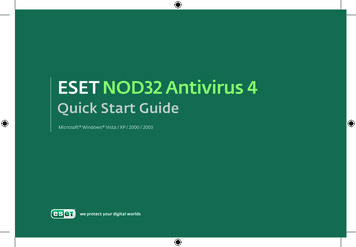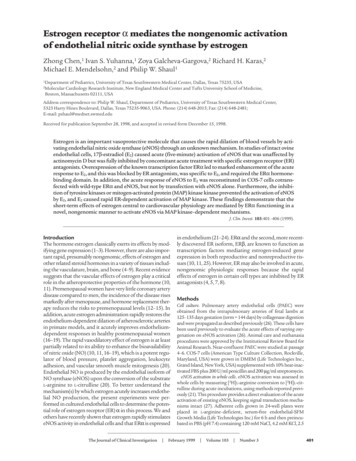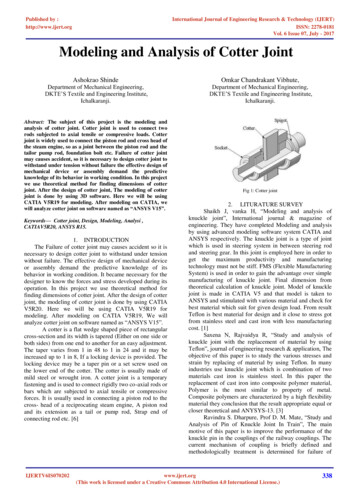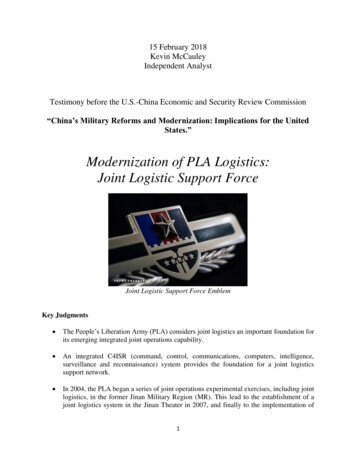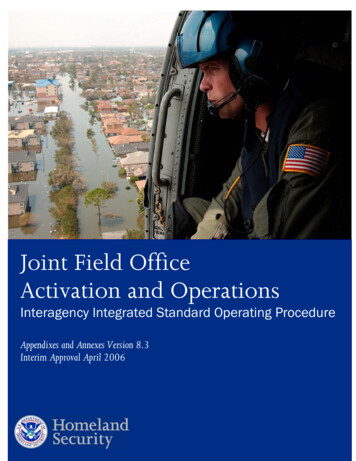
Transcription
Joint Field OfficeActivation and OperationsInteragency Integrated Standard Operating ProcedureAppendixes and Annexes Version 8.3Interim Approval April 2006
UNCLASSIFIEDTable of ContentsAppendix 1: List of Acronyms.1Appendix 2: References.11Annex A: Roles and Responsibilities.121.0National Responsibilities . 122.0Regional Responsibilities. 13Annex B: Administrative Reports .15Tab 1 to Annex B: Financial Report Template . 15Tab 2 to Annex B: Closeout Report. 16Tab 3 to Annex B: After-Action and Lessons Learned (Hotwash) Report (LLR) . 17Tab 4 to Annex B: Secretary’s Remedial Action Management Program (SEC RAMP) AAR Format. 22Annex C: Operations.231.0Principles for Building Interagency Coordination. 232.0The JFO Coordination and Support Cycle . 26Tab 1 to Annex C: Decisionmaking Process . 43Tab 2 to Annex C: CP Cover Sheet . 46Tab 3 to Annex C: Coordination Objectives. 47Tab 4 to Annex C: Assignment List . 48Tab 5 to Annex C: Assignment List Attachment. 49Tab 6 to Annex C: ICS-209-JFO, Coordination Status Summary . 50Annex D: Logistical Requirements .591.0Joint Field Office Logistics Requirements (conceptual) . 592.0Scenario One: Type I (Major) Disaster . 623.0Scenario Two: Type II Heightened Threat of Terrorism w/out WMD. 634.0Scenario Three: Type I Heightened Threat of Terrorism w/ WMD . 645.0Scenario Four: Type I Federal-to-Federal Support (Spill of National Significance). 656.0Scenario Five: Type III Federal-to-Federal Support (Chemical Release Accident) . 667.0JFO Size Requirements Estimation Worksheet. 67Tab 1 to Annex D: Pre-deployment Conference Call Checklist . 68Tab 2 to Annex D: PFO Go Kit Footprint . 69Tab 3 to Annex D: DHS/NOC Go Kit Footprint . 70Annex E: Communications and Information Sharing.711.0Purpose and Scope . 712.0Intra-JFO Communications. 71iVersion 8.3Interim Approval April 28, 2006
UNCLASSIFIED3.0External Communications. 744.0Threat Monitoring and Initial Incident Assessment . 755.0Daily Production . 756.0Secure Video Teleconferences (SVTCs). 767.0Situation Unit Watch Rotations . 778.0Logs . 77Tab 1 to Annex E: JFO “Battle Rhythm” Timeline . 78Tab 2 to Annex E: Initial Situation Report (SITREP) . 79Tab 3 to Annex E: Situation Reports . 80Tab 4 to Annex E: Urgent Situation (Spot) Reports . 90Tab 5 to Annex E: Threat Situation Report . 91Tab 6 to Annex E: HSIN-JFOnet Technical Data. 94Tab 7 to Annex E: Template JFO Information-Sharing Plan. 95Annex F: Security Procedures .106Tab 1 to Annex F: SOP for Information Classification and Handling . 107Tab 2 to Annex F: SOP for Verification of NSCI Clearances . 121Tab 3 to Annex F: SOP for Emergency Disclosure of NSCI. 122Tab 4 to Annex F: SOP for SCI/SCIF Operation. 124Tab 5 to Annex F: Template Physical and Information Security Plan. 144Tab 6 to Annex F: SOP for SBU Information Handling. 145Annex G: Principal Federal Official .1491.0Alert and Designation . 1492.0Roles and Responsibilities . 1493.0Concept of Operations . 1504.0Logistical Requirements . 1635.0Administration and Logistics . 165Tab 1 to Annex G: Reports/Scheduled Events. 168Tab 2 to Annex G: Mission Points of Contact . 169Tab 3 to Annex G: Weather. 170Tab 4 to Annex G: Request for Information . 171Tab 5 to Annex G: Communications Tracking Log. 172Tab 6 to Annex G: Attendance Tracking Log. 173Tab 7 to Annex G: Requests for Information Tracking Log. 174Tab 8 to Annex G: Financial Information. 175Tab 9 to Annex G: Domestic Emergency Support Team (DEST) . 176Annex H: Joint Field Office Organization.177Tab 1 to Annex H: Sample JFO Organization for Natural Disasters . 177iiVersion 8.3Interim Approval April 28, 2006
UNCLASSIFIEDTab 2 to Annex H: Sample JFO Organization for Terrorism Incidents . 178Tab 3 to Annex H: Sample JFO Organization for Federal-to-Federal Support. 179Tab 4 to Annex H: Sample JFO Organization for National Special Security Events . 180Annex I: Joint Information Center .181Annex J: JFO Exercise Evaluation Guidelines .182Annex K: Communications Unit .1951.0Introduction. 1952.0Communications Unit . 1953.0Roles and Responsibilities . 1984.0Concept of Operations . 205Tab 1 to Annex K: Communications Unit Staffing Patterns. 214Tab 2 to Annex K: Communications Unit Organization Chart. 215Tab 3 to Annex K: Communications Requirements Process Using TIMACS. 216Tab 4 to Annex K: Spectrum Management . 217Tab 5 to Annex K: Communications Unit Toolkit . 225iiiVersion 8.3Interim Approval April 28, 2006
UNCLASSIFIEDAppendix 1: List of AcronymsAARAfter-Action ReportAC/ICArea Command/Incident CommandADPAutomatic Data ProcessingAFOArea Field OfficeAir OpsAir Operations Branch DirectorASIAAssistant Secretary for Information AnalysisBPABlanket Purchase AgreementCBPCustoms and Border clear/ExplosiveCFOChief Financial OfficerCIACentral Intelligence AgencyCI/KRCritical Infrastructure/Key ResourcesCIOChief Information OfficerCOACourse of ActionCOMLCommunications Unit LeaderCONOPSConcept of OperationsCOOPContinuity of Operations PlanCPSDContingency Planning and Support DivisionCRCLDHS Office of Civil Rights and Civil LibertiesCSACognizant Security AuthorityCULCost Unit LeaderCVSClearance Verification System1Version 8.3Interim Approval April 28, 2006
UNCLASSIFIEDDANDocument Accountability NumberDCEDefense Coordinating ElementDCIDDirector of Central Intelligence DirectiveDCNDocument Control NumberDCODefense Coordinating OfficerDCSDefense Courier ServiceDESTDomestic Emergency Support TeamDFODisaster Field OfficeDHSDepartment of Homeland SecurityDISCDisaster Information Systems ClearinghouseDMATDisaster Medical Assistance TeamDMORTDisaster Mortuary Operational Response TeamDOBDate of BirthDODDepartment of DefenseDOJDepartment of JusticeDOMDisaster Operations ManualDPMUDisaster/Deployable Portable Morgue UnitDRCDisaster Recovery CenterDRECDeputy Regional Emergency CoordinatorDRFDisaster Relief FundDRGDisaster Readiness GroupDRMDisaster Recovery ManagerDSATDHS Situational Awareness TeamDSCADefense Support of Civilian Authorities2Version 8.3Interim Approval April 28, 2006
UNCLASSIFIEDDSENDrug Enforcement Agency SensitiveDSODisaster Safety OfficerDTDevelopment TeamDTRIMPCCDomestic Threat Response and Incident Management Policy CoordinationCommitteeDULDocumentation Unit LeaderEAPEmergency Action PlanECEmergency CoordinatorEOCEmergency Operations CenterEMIEmergency Management Institute (FEMA)EPAEnvironmental Protection AgencyEPLEvaluated Products ListERTEmergency Response TeamERT-AEmergency Response Team–Advance ElementERT-NNational Emergency Response TeamESFEmergency Support FunctionESFLGEmergency Support Function Leadership GroupFAAFederal Aviation AdministrationFACFamily Assistance CenterFAMSFederal Air Marshals ServiceFARFederal Acquisition RegulationsFBIFederal Bureau of InvestigationFCOFederal Coordinating OfficerFECCFederal Emergency Communications Coordinator3Version 8.3Interim Approval April 28, 2006
UNCLASSIFIEDFEMAFederal Emergency Management AgencyFOCFull Operating CapabilityFOUOFor Official Use OnlyFPSFederal Protective ServiceFRCFederal Resource CoordinatorFSCFinance/Admin Section ChiefGARGovernor’s Authorized RepresentativeGSAGeneral Services AdministrationGSARGeneral Services Administration Acquisition RegulationsHHSDepartment of Health and Human ServicesHSCHomeland Security CouncilHSINHomeland Security Information NetworkHSIRHomeland Security Intelligence ReportHSOMBHomeland Security Operations Morning BriefHSPDHomeland Security Presidential DirectiveIADHS Office of Intelligence and AnalysisIACIncident Advisory CouncilICIncident CommandICCIncident Communications CenterICEImmigration and Customs EnforcementICEPPIncident Communications Emergency Policy and ProceduresICPIncident Command PostICSIncident Command SystemIDPImmediate Deployment Plan4Version 8.3Interim Approval April 28, 2006
UNCLASSIFIEDIDSIntrusion Detection SystemIMSURTInternational Medical Surgical Response TeamIOInformation OfficerIOCInitial Operating CapabilityIPDHS Office of Infrastructure ProtectionIRInfraredITInformation TechnologyJFOJoint Field OfficeJFO CGJoint Field Office Coordination GroupJICJoint Information CenterJISJoint Information SystemJOCJoint Operations CenterJPASJoint Personnel Adjudication SystemJRIESJoint Regional Information Exchange SystemJTFJoint Task ForceJTTFJoint Terrorism Task ForceJRIESJoint Regional Information Exchange SystemLESLaw Enforcement SensitiveLIMDISLimited DistributionLLRLessons Learned (Hot Wash) ReportLNOLiaison OfficerLOULimited Official UseLSCLogistics Section ChiefMACCMultiagency Command Center5Version 8.3Interim Approval April 28, 2006
UNCLASSIFIEDMCRCMessage Center/Switchboard Operator/ReceptionistMERSMobile Emergency Response SupportMHATMedical Health Advisory TeamMNATMedical Needs Assessment TeamMOAMemorandum of AgreementMOBMobile Operations BranchMOUMemorandum of UnderstandingMSTManagement Support TeamNCRNational Capital RegionNCTCNational Counterterrorism CenterNGANational Geospatial Intelligence AgencyNGONongovernmental OrganizationNICCNational Infrastructure Coordinating CenterNICCLNational Incident Communications Conference LineNIMSNational Incident Management SystemNISPOMNational Industrial Security Program Operating ManualNMRTNational Medical Response TeamNOCNational Operations CenterNRCCNational Response Coordination CenterNRPNational Response PlanNSANational Security AgencyNSIClassified National Security InformationNSSENational Special Security EventNVRTNational Veterinary Response Team6Version 8.3Interim Approval April 28, 2006
UNCLASSIFIEDOCONUSOutside the Continental United StatesOEOrganizational ElementOPAOffice of Public AffairsOSCOperations Section ChiefOSLGCOffice of State and Local Government CoordinationOUOOfficial Use OnlyPAPublic AffairsPAOPublic Affairs Office/OfficerPCIIProtected Critical Infrastructure InformationPDAPersonal Digital AssistantPDAPreliminary Damage AssessmentPDDPresidential Decision DirectivePDSPractice Dangerous to SecurityPEDPortable Electronic DevicePFOPrincipal Federal OfficialPOBPlace of BirthPOEProjected Operating EnvironmentPROPINProprietary InformationPSCPlanning Section ChiefRARegional AdministratorRECRegional Emergency CoordinatorRFRadio FrequencyRFARequest for AssistanceRFIRequest for Information7Version 8.3Interim Approval April 28, 2006
UNCLASSIFIEDRISCRegional Interagency Steering CommitteeRMDRisk Management DivisionRNARapid Needs Assessment (Team)ROCRequired Operating CapabilityRONRest OvernightRRCCRegional Response Coordination CenterRRRReadiness, Response and RecoveryRULResource Unit LeaderS&TScience and TechnologySAARSecretary’s After Action ReportSACSpecial Agent in Charge (FBI)SAICSpecial Agent in Charge (USSS)SBUSensitive but UnclassifiedSCSafety CoordinatorSCISensitive Compartmented InformationSCIFSensitive Compartmented Information FacilitySCOState Coordinating OfficerSEC RAMPSecretary’s Remedial Action Management ProgramSERTSecretary’s Emergency Response Team (HHS)SFLEOSenior Federal Law Enforcement OfficialSFOSenior Federal OfficialSGISafeguards InformationSIOCStrategic Information and Operations Center (FBI)SITREPSituation Report8Version 8.3Interim Approval April 28, 2006
UNCLASSIFIEDSMBSecretary’s Morning BriefSMESubject Matter ExpertSOSecurity OfficerSOICSenior Official of the Intelligence CommunitySOPStandard Operating ProcedureSPOTREPSpot ReportSPSCIFSemi-Permanent Sensitive Compartmented Information FacilitySSISensitive Security InformationSSNSocial Security NumberSSOSpecial Security OfficerSTESecure Telephone EquipmentSTUSecure Telephone UnitSULSituation Unit LeaderSVTCSecure Video TeleconferenceSWOSenior Watch OfficerTAISTelecommunications and Automated Information SystemsTIMACSTelecommunications Information Management and Control SystemTLCTerritory Logistics CenterTSATransportation Security AdministrationTSCTerrorist Screening CenterTSCATop Secret Control AccountTSCMTechnical Surveillance CountermeasuresTSCOTop Secret Control OfficerTS/SCITop Secret/Sensitive Compartmented Information9Version 8.3Interim Approval April 28, 2006
UNCLASSIFIEDTSWATemporary Secure Working AreaUCUnified CommandUCNIUnclassified Controlled Nuclear InformationUSACEUnited States Army Corps of EngineersUSCGUnited States Coast GuardUSSOCOMUS Special Operations CommandUSSSUnited States Secret ServiceVMATVeterinary Medical Assistance TeamWMDWeapons of Mass DestructionWMO(DHS) Wireless Management Office10Version 8.3Interim Approval April 28, 2006
UNCLASSIFIEDAppendix 2: References DEST Memorandum of Understanding (MOU) between DHS and FBIHomeland Security Act of 2002National Operational Center (NOC) SOPHomeland Security Presidential Directive-5Homeland Security Presidential Directive-7Homeland Security Presidential Directive-12Incident Advisory Council (IAC) SOPNational Incident Management System (NIMS)National Response Plan (NRP)Presidential Decision Directive-39Presidential Decision Directive-62Robert T. Stafford Disaster Relief and Emergency Assistance Act11Version 8.3Interim Approval April 28, 2006
UNCLASSIFIEDAnnex A: Roles and Responsibilities1.0 National Responsibilities1.1Type III Expeditionary JFO Development Team.To facilitate the development of the planned Type III Expeditionary JFOs for each highthreat or regional area, an Expeditionary JFO Development Team (DT) will be established.Although to devising a carefully crafted, long-term Required Operating Capability (ROC)/Projected Operating Environment (POE) document or regional employment concept will be along-term initiative, DHS/FEMA regions should immediately consider interim or bridgingconcepts to deliver a more "Expeditionary" capability for JFOs should the need arise beforethe deliberate planning process can be completedThe DT will be co-chaired by DHS/FEMA and DHS/USCG. Membership of the team willinclude appropriate representatives from the Federal Bureau of Investigations, Department ofHealth and Human Services, and all DHS field elements. DHS/FEMA and DHS/USCG willcoordinate general oversight and guidance throughout the process, ensuring that the years ofexperience and existing assets utilized in the development of DFOs and Incident CommandPosts are carefully integrated into the Expeditionary JFO development process. DHS willshare relevant JFO pre-planning information through established channels, including throughthe Regional Interagency Steering Committees (RISCs) and the national ESF LeadershipGroup (ESFLG), with other NRP agencies and seek their input as appropriate.1.2Expeditionary JFO Development Team Taskings1.2.1 Develop an Expeditionary JFO Required Operating Capability (ROC) andProjected Operating Environment (POE) consistent with: The JFO SOPThreat environmentDemographicsThe Homeland Security Council’s report, The Federal Response to HurricaneKatrina: Lessons LearnedCapable of Type III initial operating capability (only);Capable of being self-supporting for up to three weeks; andCapable of operating in austere environments with minimal functioninginfrastructure.1.2.2 Develop an Expeditionary JFO Employment Strategy consistent with: Regional JFO Development Team inputs (see section 2.0 to this Annex)The JFO SOP12Version 8.3Interim Approval April 28, 2006
UNCLASSIFIED Threat environmentDemographicsExisting political structureLevel of local and State readiness and operational systemsExisting regional Federal structure; andLocations to stage the Expeditionary JFO so as to be deployable and functioningwithin 12 hours of deployment notification from any RRCC.1.2.3Develop an Expeditionary JFO staffing plan, consistent with theExpeditionary JFO ROC/POE, supporting all organizational elements of an initialoperating capability Type III Expeditionary JFO. These plans should identify theorganizations or representatives from the appropriate DHS elements needed to maintainthe Expeditionary JFO readiness posture once established for each region.2.0 Regional Responsibilities2.1JFO Developmental Organizations.To facilitate the development of future JFOs and other DHS facilities for each high-threat orregional area, a JFO DT will be established immediately upon approval of this SOP. JFODTs are intended to ensure that DHS can meet its intended timeframes for establishing JFOsand deploying Expeditionary JFOs (rather than based on threat streams, etc.) for all areasdeemed by the JFO DT to be risk for an Incident of National Significance or other incidentrequiring a coordinated Federal response.These teams will be co-chaired by the appropriate DHS/FEMA regional office, DHS/USSSfield office, and/or FBI field office. Membership of the team will include all DHS fieldelements within the defined urban threat area or regional area. DHS/FEMA will coordinategeneral oversight and guidance throughout the process, ensuring that the years of experienceand existing assets utilized in the development of DFOs are carefully integrated into the JFOdevelopmental process. The Under Secretary for Preparedness will assign organizationalresponsibility to the appropriate DHS/FEMA elements to ensure oversight of the process.2.2Regional JFO Development Team Taskings2.2.1 Develop a JFO Strategy consistent with:JFO SOPNSSE requirementsThreat environmentDemographicsExisting political structureLevel of local and State readiness and operational systemsExisting regional Federal structure; and13Version 8.3Interim Approval April 28, 2006
UNCLASSIFIED The Expeditionary JFO ROC/POE and Expeditionary JFO Strategy (see section 1 tothis Annex, above).2.2.2Develop JFO staffing plans, consistent with the JFO SOP, supporting allorganizational elements of a fully functional JFO for the specific regional area, includingthe Expeditionary JFO and/or AFO when those capabilities are established.Expeditionary staffing plans should identify the organizations or representatives from theappropriate DHS elements needed to maintain the JFO readiness posture once establishedfor each region or urban threat area. AFO staffing plans should identify the logisticalcapabilities required to simultaneously support four JFOs and three AFOs across tworegions.1.2.3Support the National Expeditionary Development Team. In addition tomanaging its own potential JFO deployments, each regional DT should support thedevelopment of the Expeditionary JFO ROC/POE.2.2.4Develop an Expeditionary JFO IDP. In addition to pre-identification of nonexpeditionary facilities, each regional DT should develop an Expeditionary JFOImmediate Deployment Plan (IDP) to support any activation resulting from a no-noticethreat or actual incident. This plan should be activated/implemented in the event of aWMD incident and in the absence of an available functional site. It would provide acritical action plan that provides Federal, State, local, and private-sector contacts withthose organizations that have previously agreed to support the use of the ExpeditionaryJFO capability.14Version 8.3Interim Approval April 28, 2006
UNCLASSIFIEDAnnex B: Administrative ReportsTab 1 to Annex B: Financial Report Template[RESERVED]15Version 8.3Interim Approval April 28, 2006
UNCLASSIFIEDTab 2 to Annex B: Closeout Report[RESERVED]16Version 8.3Interim Approval April 28, 2006
UNCLASSIFIEDTab 3 to Annex B: After-Action and Lessons Learned (Hotwash)Report (LLR)1.0GeneralThe After-Action Report is a narrative summary of the operations, contingency response, orexercise. An AAR may contain specific associated lesson(s) learned and primarily: Summarizes JFO operations or exercises,Assesses how well the NRP’s objectives were accomplished, andDocuments major lessons learned for follow-up action, including action by theSecretary of Homeland Security through the SEC RAMP.The Planning Section Chief is responsible for initiating the AAR/LLR process prior todemobilization of the Planning Section. The PFO/FRC/FCO, as appropriate, is responsible foroverseeing the AAR/LLR process in a manner to comply with the deadline.The Lessons Learned (Smart Practice) Report is a standalone record that documents specificissues, problem areas, best practices, and work-arounds pertaining to operations, contingencyresponse, or exercises. Each lesson learned should be prepared so that it does not rely on anotherpart of the doc
NISPOM National Industrial Security Program Operating Manual NMRT National Medical Response Team NOC National Operations Center . NSA National Security Agency NSI Classified National Security Information NSSE National Special Security Event NVRT National Veterinary Response Team . UNCLASSIFIED 7 Version 8.3 Interim Approval April 28, 2006
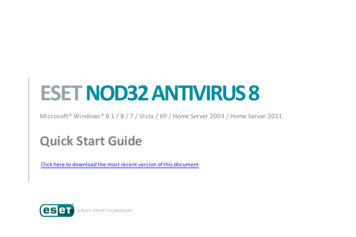
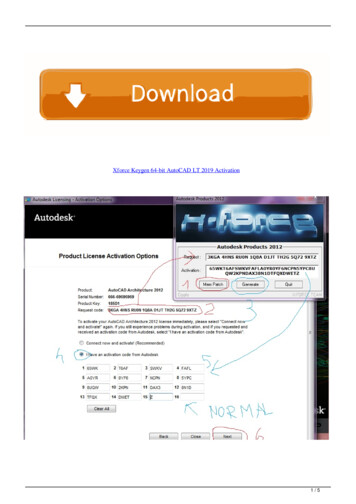
![Office 2010 Professional Plus Com Ativador Serial Keyl [EXCLUSIVE]](/img/61/office-2010-professional-plus-com-ativador-serial-keyl-exclusive.jpg)

